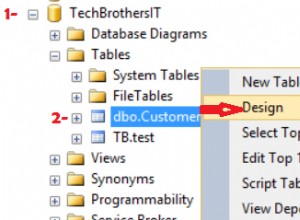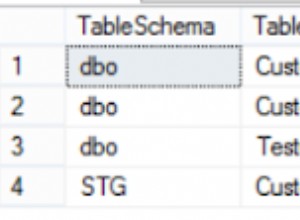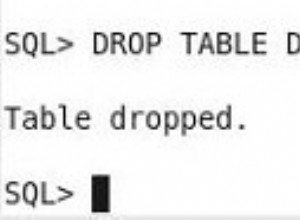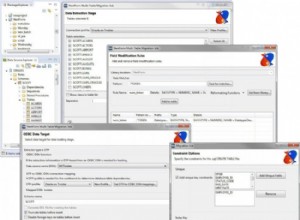La solución definitiva en mi caso, evitando makecert y openssl, fue usar Powershell y BouncyCastle. Bifurqué el repositorio de PSBouncyCastle de PSBouncyCastle por RLipscombe y impulsó 1.8.1 Bouncy Castle. Mi versión bifurcada es la que he usado para el script, la bifurcación reside en Bifurcado:PSBouncyCastle.Nuevo .
Luego usé StackOverflow:C# Generate Certificates on the Fly como inspiración para escribir el siguiente powershell a continuación, lo agregaré a mi GitHub y lo comentaré, y lo modificaré tan pronto como lo haga :
Import-Module -Name PSBouncyCastle.New
function New-SelfSignedCertificate {
[CmdletBinding()]
param (
[string]$SubjectName,
[string]$FriendlyName = "New Certificate",
[object]$Issuer,
[bool]$IsCA = $false,
[int]$KeyStrength = 2048,
[int]$ValidYears = 2,
[hashtable]$EKU = @{}
)
# Needed generators
$random = New-SecureRandom
$certificateGenerator = New-CertificateGenerator
if($Issuer -ne $null -and $Issuer.HasPrivateKey -eq $true)
{
$IssuerName = $Issuer.IssuerName.Name
$IssuerPrivateKey = $Issuer.PrivateKey
}
# Create and set a random certificate serial number
$serial = New-SerialNumber -Random $random
$certificateGenerator.SetSerialNumber($serial)
# The signature algorithm
$certificateGenerator.SetSignatureAlgorithm('SHA256WithRSA')
# Basic Constraints - certificate is allowed to be used as intermediate.
# Powershell requires either a $null or reassignment or it will return this from the function
$certificateGenerator = Add-BasicConstraints -isCertificateAuthority $IsCA -certificateGenerator $certificateGenerator
# Key Usage
if($EKU.Count -gt 0)
{
$certificateGenerator = $certificateGenerator | Add-ExtendedKeyUsage @EKU
}
# Create and set the Issuer and Subject name
$subjectDN = New-X509Name -Name ($SubjectName)
if($Issuer -ne $null) {
$IssuerDN = New-X509Name -Name ($IssuerName)
}
else
{
$IssuerDN = New-X509Name -Name ($SubjectName)
}
$certificateGenerator.SetSubjectDN($subjectDN)
$certificateGenerator.SetIssuerDN($IssuerDN)
# Authority Key and Subject Identifier
if($Issuer -ne $null)
{
$IssuerKeyPair = ConvertTo-BouncyCastleKeyPair -PrivateKey $IssuerPrivateKey
$IssuerSerial = [Org.BouncyCastle.Math.BigInteger]$Issuer.GetSerialNumber()
$authorityKeyIdentifier = New-AuthorityKeyIdentifier -name $Issuer.IssuerName.Name -publicKey $IssuerKeyPair.Public -serialNumber $IssuerSerial
$certificateGenerator = Add-AuthorityKeyIdentifier -certificateGenerator $certificateGenerator -authorityKeyIdentifier $authorityKeyIdentifier
}
# Validity range of the certificate
[DateTime]$notBefore = (Get-Date).AddDays(-1)
if($ValidYears -gt 0) {
[DateTime]$notAfter = $notBefore.AddYears($ValidYears)
}
$certificateGenerator.SetNotBefore($notBefore)
$certificateGenerator.SetNotAfter($notAfter)
# Subject public key ~and private
$subjectKeyPair = New-KeyPair -Strength $keyStrength -Random $random
if($IssuerPrivateKey -ne $null)
{
$IssuerKeyPair = [Org.BouncyCastle.Security.DotNetUtilities]::GetKeyPair($IssuerPrivateKey)
}
else
{
$IssuerKeyPair = $subjectKeyPair
}
$certificateGenerator.SetPublicKey($subjectKeyPair.Public)
# Create the Certificate
$IssuerKeyPair = $subjectKeyPair
$certificate = $certificateGenerator.Generate($IssuerKeyPair.Private, $random)
# At this point you have the certificate and need to convert it and export, I return the private key for signing the next cert
$pfxCertificate = ConvertFrom-BouncyCastleCertificate -certificate $certificate -subjectKeyPair $subjectKeyPair -friendlyName $FriendlyName
return $pfxCertificate
}
Algunos ejemplos de uso de este powershell serían:
Generar una CA raíz
$TestRootCA = New-SelfSignedCertificate -subjectName "CN=TestRootCA" -IsCA $true
Export-Certificate -Certificate $test -OutputFile "TestRootCA.pfx" -X509ContentType Pfx
Generar un autofirmado estándar
$TestSS = New-SelfSignedCertificate -subjectName "CN=TestLocal"
Export-Certificate -Certificate $TestSS -OutputFile "TestLocal.pfx" -X509ContentType Pfx
Generar un certificado, firmando con un certificado raíz
$TestRootCA = New-SelfSignedCertificate -subjectName "CN=TestRootCA" -IsCA $true
$TestSigned = New-SelfSignedCertificate -subjectName "CN=TestSignedByRoot" -issuer $TestRootCA
Export-Certificate -Certificate $test -OutputFile "TestRootCA.pfx" -X509ContentType Pfx
Export-Certificate -Certificate $test -OutputFile "TestRootCA.pfx" -X509ContentType Pfx
Generar un autofirmado con uso específico
$TestServerCert = New-SelfSignedCertificate -subjectName "CN=TestServerCert" -EKU @{ "ServerAuthentication" = $true }
Tenga en cuenta que el parámetro -EKU acepta a través de splatting, lo hace para garantizar que todo lo agregado a Add-ExtendedKeyUsage se pase de manera válida. Acepta los siguientes usos de certificados:
- Firma digital
- No repudio
- Clave de cifrado
- Cifrado de datos
- Acuerdo clave
- Signo de certificado de clave
- CrlSign
- Solo cifrado
- Solo descifrar
Esto se ajusta a mi necesidad y parece funcionar en todas las plataformas de Windows que usamos para entornos dinámicos.




